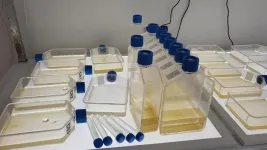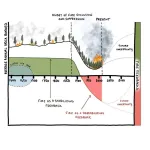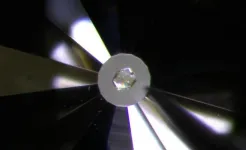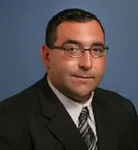(Press-News.org) CORVALLIS, Ore. – Certain groups of consumers appear to be open to drinking smoke-impacted wines, a finding in a new study that could provide market opportunities for winemakers increasingly dealing with the effects of wildfire smoke on grapes.
The study by researchers at Oregon State University and in New Zealand found that consumers, particularly those that like smokey flavors in food and beverages, are open to drinking smoke-impacted wines. They also found that the type of information on the label can modulate consumer acceptance.
“This research provides vital information for the wine industry,” said Elizabeth Tomasino, a professor of enology at Oregon State. “It demonstrates that with certain wine drinkers there is a potential market for these smoke-impacted wines.”
As the number and size of wildfires grow globally, the wine industry has been heavily impacted. For example, an economic analysis of the 2020 wildfires on the West Coast of the United States estimated wine industry losses up to $3.7 billion.
Following the 2020 fires, a research team, led by Oregon State scientists, received a $7.65 million grant from the U.S. Department of Agriculture to study the impact of smoke on wine.
Since then, the researchers have made several key advances. They discovered a class of compounds that contribute to smoke impact in grapes. They also developed spray-on coatings for grapes that have shown promise in preventing off flavors in wines that result from contact with wildfire smoke.
The latest research, published in the journal Food Research International, focuses on consumer attitudes toward smoke-impacted wine, a topic that has received very little attention.
For the study, Tomasino and Jenna Fryer, a doctoral student in her lab, sent smoke-impacted and non-smoke wine made from Oregon pinot noir grapes to New Zealand. There, working with Amanda Dupas de Matos and Joanne Hort at Massey University, they recruited 197 participants for the study.
They conducted the research in New Zealand, a region where winemaking has not been significantly impacted by wildfire, because they were interested in how people would respond to the wines. Future research will compare the results from New Zealand to findings from tasting panels in Oregon and Ohio.
With the research in New Zealand, two clusters of consumers were identified, one that liked the smoke-impacted wine (110 people) and the other that disliked it (87 people).
Findings of the study included:
The smoke-liking group had an average liking score of 6.86 out of a nine-point scale.
The smoke-disliking group had an average score of 3.26.
The introduction of labels, versus unlabeled wine, increased liking of the smoke-impacted wines for the smoke-dislikers from just over three to more than five on the nine-point scale. One of the labels overtly referenced wildfires with the words “Smoke Stack, experience the 2020 vintage with this unique, lightly smokey wine.”
The different labels didn’t have much of an impact on the smoke-likers, but their average scores were still above six, outpacing the dislikers.
The findings indicate that there are potential tools winemakers can use to make a smoke-impacted wine viable for the market, the researchers say. One option is blending, a common winemaking technique that in this case could involve mixing a smoke-impacted wine with a non-impacted wine. Winemakers can also take different approaches to labeling and marketing to specifically target the smoke-liking group.
“Our findings indicate that there is more forgiveness among consumers for these smokey wines than winemakers think,” Tomasino said. “It seems winemakers have a lot more options if they want to sell wine made with these grapes.”
END
Study finds consumer openness to smoke-impacted wines, offering new market opportunities
2025-02-12
ELSE PRESS RELEASES FROM THIS DATE:
Why we need to expand the search for climate-friendly microalgae
2025-02-12
New research has highlighted microalgae’s capacity as a solution in the fight against climate change, but researchers warn that “smart microalgal bioprospecting” is needed to unlock its full potential.
The study highlights the vast, largely unexplored capacity of microalgae to mitigate CO2 emissions while driving sustainable industry.
“Microalgae have remarkable properties that make them an ideal tool for tackling climate change,” said lead author, PhD candidate Joan Labara Tirado from the University of Technology Sydney (UTS).
The review paper, The need for smart microalgal bioprospecting was ...
Fewer forest fires burn in North America today than in the past—and that's a bad thing
2025-02-12
Fewer wildfires burn in North American forests today than in previous centuries, increasing the risk of more severe wildfires, according to research published this week in Nature Communications. The findings may seem counterintuitive, but frequent low-lying surface fires often maintain balance in forests by reducing fuel sources across large areas.
The new study led by the Cooperative Institute for Research in Environmental Sciences (CIRES) at the University of Colorado Boulder and the U.S. Forest Service’s Rocky Mountain Research Station ...
Older people in England are happier now than before the COVID pandemic, new national study suggests
2025-02-12
Older people have greater general happiness, life satisfaction and sense of purpose than they did before the Covid-19 pandemic.
That’s according to a new study which tracked 3,999 over 50s in England for 11 years, published today in the peer-reviewed journal, Aging and Mental Health.
Analysing data to understand positive psychological well-being and depression within this group, an expert team from UCL (University College London), funded by the National Institute of Ageing, a consortium of UK government departments coordinated by the National Institute ...
Texas A&M chemist wins NSF CAREER Award
2025-02-11
Dr. Alison Altman, an assistant professor in the Texas A&M Chemistry Department, has received a National Science Foundation (NSF) CAREER Award, which supports early-career faculty in research and education. The award recognizes her work on underexplored elements of the periodic table and her dedication to teaching. For Altman, it’s a launchpad for future discoveries.
“It’s an honor to receive this award, as it acknowledges not just my research program but also my teaching efforts,” ...
Micro-nano plastics make other pollutants more dangerous to plants and intestinal cells
2025-02-11
Micro- and nanoscale plastic particles in soil and water can significantly increase how much toxic chemicals plants and human intestinal cells absorb, according to two new studies from Rutgers Health that raise fresh concerns about food safety from plastic pollution.
The first study in NanoImpact found that lettuce exposed to both nanoscale plastic particles and common environmental pollutants such as arsenic took up substantially more of the toxic substances than plants exposed to the pollutants, alone confirming the risks of polycontamination of our food chain. A companion study in Microplastics journal showed ...
Study of female genital tract reveals key findings
2025-02-11
Seeking to understand what constitutes a healthy vaginal microbiome, a global research collaboration that includes a Rutgers-New Brunswick scientist has reported a series of findings, including identifying which bacteria thwart vaginal disease and determining that microbiomes vary significantly across human populations.
Authors of the study, published in Trends in Microbiology, are part of a Belgium-based initiative called the Isala Sisterhood. Members of the group aim to inspire research on microbiomes worldwide by creating a “reference map” of vaginal microbiota. Launched in 2020 at the University of Antwerp, the project has expanded to include more than 3,000 ...
Pitt Engineering Professor Fang Peng elected to National Academy of Engineering
2025-02-11
The National Academy of Engineering (NAE) today announced that University of Pittsburgh Professor Fang Peng, an internationally acclaimed power electronics researcher, is among the newest cohort elected to the academy. The NAE is recognizing Peng for “contributions to the development of high-powered electronic technologies for advanced power grid and energy conversion.”
Peng, the RK Mellon Endowed Chair Professor of Electrical and Computer Engineering and Director of the Energy GRID Institute at Pitt’s Swanson School of Engineering, ...
Short-course radiation therapy effective for endometrial cancer patients
2025-02-11
In a randomized clinical trial, researchers from Huntsman Cancer Institute at the University of Utah (the U) have found that short-course, higher dose vaginal brachytherapy for endometrial cancer had similar effectiveness to more frequent, lower dose sessions.
Gita Suneja, MD, MS, physician-scientist at Huntsman Cancer Institute and professor of radiation oncology at the U, is the first author of the SAVE trial report—which stands for, Short-Course Adjuvant Vaginal Cuff Brachytherapy in Early Endometrial Cancer Compared with Standard of Care.
“There ...
Breast cancer treatment advances with light-activated ‘smart bomb’
2025-02-11
Scientists have developed new light-sensitive chemicals that can radically improve the treatment of aggressive cancers with minimal side effects. In mouse tests, the new therapy completely eradicated metastatic breast cancer tumors.
The novel chemicals, called cyanine-carborane salts, and their role in the next-generation of cancer treatments, are described in a new article published in Angewandte Chemie, a journal of the German Chemical Society.
Photodynamic therapy, or PDT, has been used for decades to treat forms of skin and bladder cancers. It works by flooding a patient’s body with light-sensitive chemicals that accumulate in cancer cells. ...
JSCAI article at THT 2025 sets the standard for training pathways in interventional heart failure
2025-02-11
WASHINGTON–Interventional heart failure (IHF) has rapidly evolved as a critical subspecialty within cardiology at the crossroads of advanced heart failure and interventional cardiology. The increasing complexity of patient care—spanning both pharmacological treatments and an expanding array of device-based therapies—has underscored the urgent need for a standardized approach to training and career development in this field.
That’s the message from experts in a comprehensive review, “Charting the Course for Careers in Interventional Heart ...







